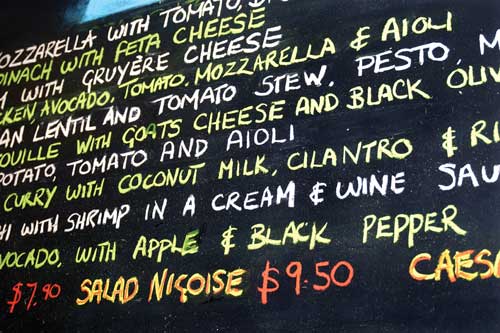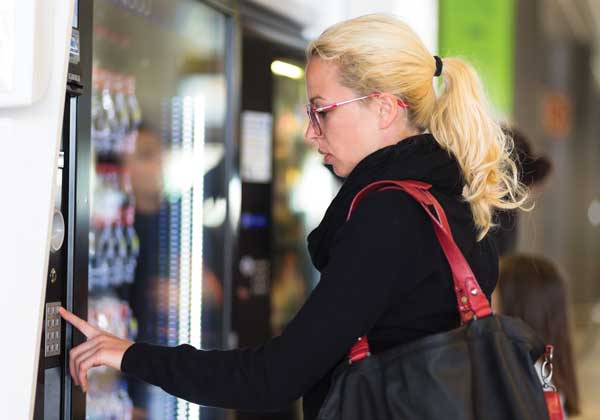Calories Count on Menus
FOOD SAFETY & QUALITY
 In December 2014 the U.S. Food and Drug Administration (FDA) issued final regulations requiring that calorie information for standard menu items be listed on menus and menu boards and foods sold in vending machines. Restaurants and similar establishments were to comply by December 1, 2016, but the compliance date has been put on hold until one year after a final compliance guide has been issued. In the meantime, restaurant chains and providers of analytical testing services and nutritional analysis databases and software are gearing up for the expected increase in demand for their services.
In December 2014 the U.S. Food and Drug Administration (FDA) issued final regulations requiring that calorie information for standard menu items be listed on menus and menu boards and foods sold in vending machines. Restaurants and similar establishments were to comply by December 1, 2016, but the compliance date has been put on hold until one year after a final compliance guide has been issued. In the meantime, restaurant chains and providers of analytical testing services and nutritional analysis databases and software are gearing up for the expected increase in demand for their services.
Background
The FDA proposed a menu labeling rule and vending machine labeling rule on April 6, 2011, to meet the menu labeling provisions of the Patient Protection and Affordable Care Act, which has a goal of labeling the calorie contents of meals provided in restaurants and other foodservice establishments to help reduce obesity. The FDA has estimated that approximately 298,600 establishments in 2,130 restaurant chains would be affected by the menu labeling rule but that the estimated benefits—increased awareness of the calorie content of foods offered for sale in restaurants and other establishments, which may reduce consumers’ calorie intake and contribute to a reduction in obesity in the U.S. population—will exceed costs by $477.9 million on an annualized basis over 20 years. The FDA did not quantify benefits for the vending machine labeling rule.
The FDA published its final rules—“Nutrition Labeling of Standard Menu Items in Restaurants and Similar Retail Food Establishments” and “Calorie Labeling of Articles of Food in Vending Machines”—on December 1, 2014, with a compliance date of December 1, 2015, for menu labeling and December 1, 2016, for vending machine labeling. On July 9, 2015, the agency extended the compliance date for the menu labeling rule to December 1, 2016.
On September 16, 2015, the FDA issued “Draft Guidance for Industry: A Labeling Guide for Restaurants and Retail Establishments Selling Away-From-Home Foods – Part II.” Intended to help restaurants and similar establishments understand the requirements of the final menu labeling rule, the draft guidance responds to many of the most frequently asked questions that the agency received.
On December 18, 2015, Congress enacted an omnibus appropriations bill that said that none of the funds could be used to implement, administer, or enforce the menu labeling final rule until December 1, 2016, or one year after issuance of a final guidance document on menu labeling, whichever is later. Accordingly, on March 9, 2016, the FDA announced that it was delaying enforcement of the final menu labeling regulation to one year after it issues a final guidance, would consider all comments received, and would issue a final guidance as soon as possible. In addition, on February 12, 2016, the U.S. House of Representatives passed a bill (H.R. 2017) that would, among other things, modify the menu labeling final rule. It has been received by the U.S. Senate and referred to the Committee on Health, Education, Labor, and Pensions.
 Labeling Requirements
Labeling Requirements
The menu labeling rule requires restaurants and similar retail food establishments that are part of a chain with 20 or more locations doing business under the same name, selling restaurant-type food, and offering substantially the same menu items to provide calorie and other nutrition information for standard menu items. Chains with fewer than 20 locations and other establishments not otherwise covered by the rule can choose to adhere to the federal requirements—and thus not be subject to state or local nutrition labeling requirements that differ from the federal requirements—by registering with the FDA every two years. The rule also applies to food facilities in movie theaters and amusement parks and to alcoholic beverages listed on the menu. Menus and menu boards must display the following:
• The number of calories in each listed standard menu item as usually prepared and offered for sale. This statement must appear adjacent to the name or price of the item on the menu or menu board. Calories for standard menu items that are self-service or on display must be declared on either signs adjacent to the items, a sign attached to the sneeze guard, or a single sign or placard listing the calorie declaration for several food items along with the names of the food items.
• A statement of suggested daily calorie intake that reads “2,000 calories a day is used for general nutrition advice, but calorie needs vary.” Menus and menu boards targeted to children can substitute or add the statement “1,200 to 1,400 calories a day is used for general nutrition advice for children ages 4–8 years, but calorie needs vary” or “1,200 to 1,400 calories a day is used for general nutrition advice for children ages 4–8 years and 1,400 to 2,000 calories a day for children ages 9–13 years, but calorie needs vary.” The statement must appear at the bottom of each page of the menu and the bottom of the menu board.
• A statement that additional nutrition information is available. In addition to calorie information, restaurants are also required to provide written nutrition information about their standard menu items, including total fat, calories from fat, saturated fat, trans fat, cholesterol, sodium, total carbohydrates, dietary fiber, sugars, and protein. This information can be provided on posters, tray liners, signs, counter cards, handouts, booklets, computers, or kiosks. “Additional nutrition information available upon request” must appear in menus at the bottom of the first page with menu items and at the bottom of the menu board. For both menus and menu boards, the statement of availability must be placed immediately above, below, or beside the statement of suggested daily calorie intake.
Vending machines must display the calorie content of foods sold in the machine on a sign such as a small placard, sticker, or poster near the food or the selection button; it can also be electronically or digitally displayed. The requirement applies to machines operated by a person owning or operating 20 or more machines. Contact information regarding the operators must also be displayed.
--- PAGE BREAK ---
Determining Calorie Values
The calorie and other nutrient information can be determined by any of the following methods:
• Calculations based on nutrient databases. Upon the FDA’s request, establishments must provide the name, version, and date of the database used and, if a software application is used, the name and version of the software used, the name of the software company, and the website address for the database. Additional information substantiating nutrient values must also be provided for nutrient databases upon request.
• Values listed in a cookbook. Upon the FDA’s request, establishments must provide the name, author, and publisher of the cookbook used; information provided by the cookbook, author, or publisher about how the nutrition information for the recipes was obtained (if available); a copy of the recipe used to prepare the standard menu item; and a copy of the cookbook’s nutrition information for that item.
• Laboratory analysis. Upon the FDA’s request, establishments must provide a copy of the recipe for the standard menu item, the name and address of the laboratory performing the analysis, and copies of analytical worksheets, including the analytical method used to determine and verify the nutrition information
• Other reasonable means. Examples include use of the Nutrition Facts label on packaged foods and the FDA’s nutrient values for raw fruits and vegetables and for cooked fish.
For each of the aforementioned methods, the establishment must, upon the FDA’s request, provide a statement signed and dated by a responsible employee at the covered establishment or its corporate headquarters or parent entity who can certify that the information contained in the nutrient analysis is complete and accurate, and a statement signed and dated by a responsible employee at the covered establishment certifying that the establishment has taken reasonable steps to ensure that the method of preparation (e.g., types and amounts of ingredients in the recipe, cooking temperatures) and amount of a standard menu item offered for sale adhere to the factors on which the nutrient values were determined.
 Testing Labs and Software Providers
Testing Labs and Software Providers
Analytical laboratories provide nutrient analysis of products, and database and software companies provide software for nutrition labeling purposes. Such companies can expect to increase their business as a result of the menu labeling regulations. Here are some of the companies offering analytical and menu labeling services.
Applied Data Corp., Tampa, Fla. (applieddatacorp.com), offers NutriGen Recipe Manager, which facilitates recipe and ingredient management by helping companies define standardized recipes and combining vendor-supplied raw ingredients and sub-assemblies with their own sub-recipes. It generates ingredient panels, Nutrition Facts panels, and calorie counts for menu labeling.
Axxya Systems, Woodinville, Wash. (nutritionistpro.com), offers Nutritionist Pro food labeling and formulation software and has added an online option for chefs and restaurateurs that can be accessed from any device, which makes working with a busy restaurant team faster and easier. The Nutritionist Pro Menu Creation Module and the online Nutritionist Pro NexGen Recipe and Label Creator are both able to generate nutrient profiles for recipe/menu items. The software also can create menus with sub-recipes to see calorie ranges for different combination meals.
ESHA Research, Salem, Ore. (esha.com), added a food menu feature to its Genesis R&D food formulation and labeling software in August 2014 to help restaurants prepare for the menu labeling regulations. The new feature simplifies menu creation by allowing the grouping of foods by category, easy display of user-defined headings, and options for including allergen and ingredient statements, and it prints a food menu report that can be configured with the government-recommended nutrient set and printed or exported to other programs. The company also offers consulting services and provides recipe analysis; recently published the eBook Restaurant Menu Labeling, What You Need to Know, which provides a detailed overview of the proposed regulations; and will present a webinar on June 14, 2016, on menu labeling using the food menu feature.
Eurofins QC Inc., Horsham, Penn. (qclaboratories.com), provides the nutrition data needed for compliance with the menu labeling regulation. It offers chemical analysis of products for nutrition labeling, or analysis based on the product’s components and percentages provided by the manufacturer or restaurant.
--- PAGE BREAK ---
Food and Drink Resources, Centennial, Colo. (foodanddrinkresources.com), offers nutritional analysis and recipe re-development. Using a combination of food data from various databases, the company analyzes all the ingredients in a recipe and provides recipe revisions and ingredient substitutions to meet established nutrition standards and labeling requirements.
FoodCalc, San Francisco, Calif. (foodcalc.com), has been offering the MenuCalc software program for restaurants since 2010. Its extensive online database of previously analyzed ingredients allows restaurants to calculate the nutritional value of their recipes and menus. Users enter their recipe information and serving sizes and obtain nutrition results instantaneously. The company also offers webinars, newsletters, and videos, as well as a white paper and checklist for things to consider when gathering recipe information, to help restaurants avoid missing important ingredients such as olive oil drizzled on flatbread before serving.
Healthy Dining, San Diego, Calif. (healthydiningfinder.com), provides nutrient analysis, recipe and menu consultation, menu labeling compliance and training, auditing, and validation to help restaurants comply with menu labeling regulations. Its website provides nutrition information on more than 1,000 restaurant brands.
Medallion Labs, Minneapolis, Minn. (medallionlabs.com), offers nutritional analysis and consulting services. Its website details the methods of analysis used.
MenuTrinfo, Fort Collins, Colo. (menutrinfo.com), offers menu labeling nutritional analysis packages. Its website includes blogs discussing the menu labeling regulations and the need for certification of the posted nutritional values. It also offers a white paper titled “7 Steps to Menu Labeling,” a webinar, and a newsletter providing information on trends and laws in the foodservice industry.
Merieux NutriSciences, Chicago, Ill. (merieuxnutrisciences.com), provides analytical nutrient testing, database recipe analysis, restaurant recipe nutrient review, ingredient review, and nutrient content review.
Midwest Laboratories, Omaha, Neb. (midwestlabs.com), offers several analytical packages, including basic (calories), advanced (calories, protein, carbohydrates, fat, and sodium), and strict (calories, protein, carbohydrates, fat, sodium, trans fat, saturated fat, sugar, and total dietary fiber). The company also offers consulting services.
Northland Laboratories, Northbrook, Ill. (northlandlabs.com), offers analytical and other services. Its website includes news and updates on menu labeling regulations and other food quality topics.
NPA Laboratories LLC, Santa Ana, Calif. (testing-laboratory.com), offers menu analysis, including calories, calories from fat, total fat, saturated fat, trans fat, cholesterol, sodium, total carbohydrates, dietary fiber, sugars, and protein. It also provides test method development and validation.
Nutritionix, Washington, D.C. (nutritionix.com), provides consulting and menu labeling services. Its web-based management platform allows restaurants to instantly publish nutrition data to the web, mobile web, and digital menu boards. It has a database that includes information on more than 598,000 food items, including more than 107,000 items from more than 600 restaurants, and a blog titled “Menu Labeling for Restaurants: The Complete Summary.”
Owl Software, Columbia, Mo. (owlsoft.com), has made modifications to the TechWizard nutrition labeling software to make it easier to obtain key information and output the information required for menu labeling. It also provides custom solutions to meet the specific requirements of its customers and interactive webinars.
SweetWARE, Oakland, Calif. (sweetware.com), is beta testing nutraCoster Professional 3.0 nutrition analysis and recipe/formula costing software, scheduled for release in third quarter 2016. Users can create menus using nutraCoster recipes, ingredients, or another menu. This allows them to build a top-level menu by combining a series of sub-menus such as appetizers, soups, entrees, and desserts and print menu reports that include the nutrition values for each menu item or create a nutrition grid for part or all of the menu. It can also calculate the cost and profitability of each menu item and generate a profit analysis for the menu as a whole. It also has new features related to Nutrition Facts labeling. The company is also planning to add a menu designer module that will allow users to create PDF menus.
Restaurant Association Prepares for Menu Labeling
The National Restaurant Association (NRA), the world’s largest foodservice trade association, has long supported a nationwide, uniform menu-labeling standard that provides flexibility for restaurants and preempts a patchwork of state and local laws. Joan McGlockton, the NRA’s vice president of industry relations and food policy, said that the association remains focused on national preemption, legal protections covered by the reasonable basis standard, and disclosure of calories at all points of ordering. As the FDA prepares further guidance, she said, the NRA will continue to work with its members and the agency to address issues of concern and ensure a smooth transition for restaurants and consumers. The association has partnered with nutrition company Healthy Dining to provide restaurants with access to food and menu analysis and implementation of best practices.
 Neil H. Mermelstein, IFT Fellow, Editor Emeritus of Food Technology
Neil H. Mermelstein, IFT Fellow, Editor Emeritus of Food Technology
[email protected]


